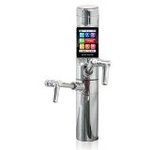Water is life, life is water. Our bodies are made of water and the type of water we put into our bodies is important. Not only clean, non-toxic water, but we now have the option of drinking alkaline water. Alkaline water, like high alkaline foods, works as a natural anti oxident in your body, fighting diseases and illness. This alkaline water filter can be placed next to your kitchen faucet or anywhere that you have a water line. Using electricity, it ionizes the water to create your choice of 7.0, 8.0, 9.0 or 10.0 ph water. It also has the ability to create acid water used for cleaning and sterilization. This is the water that is able to remove pesticides from your fruits and vegetables. This one unit provides an abundance of health benefits.
Alkaline water, like high alkaline foods, works as a natural anti oxident in your body, fighting diseases and illness. This alkaline water filter can be placed next to your kitchen faucet or anywhere that you have a water line. Using electricity, it ionizes the water to create your choice of 7.0, 8.0, 9.0 or 10.0 ph water. It also has the ability to create acid water used for cleaning and sterilization. This is the water that is able to remove pesticides from your fruits and vegetables. This one unit provides an abundance of health benefits.
Our journey to natural water filtratration, harvesting and storage has led us to commit to an aesthetic that matches our spirit. This water feature, created by Vidal Bitton, is part of a larger rainwater harvesting system that we are working on. Besides
 the beauty and the 'zen' of the design, first pond is going to be filled with water plants that naturally clean the water. The visual of natural materials and plants unites with the sound of water to create a peaceful relaxing area to be in.
the beauty and the 'zen' of the design, first pond is going to be filled with water plants that naturally clean the water. The visual of natural materials and plants unites with the sound of water to create a peaceful relaxing area to be in.
Finally, our water journey leads us to a river rock style floor that, as in the water fall, commands instant relaxation as you enter the Wellness center. Our center has a 'shoes off' rule at the door so everyone gets the pleasure of walking on this wonderful floor.
All related to water, all related to healing and wellness, all features that benefit our lives.
Namaste
Christine



